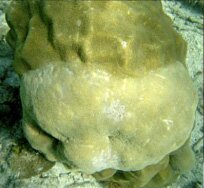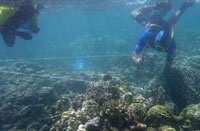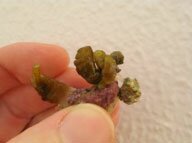The Coral Bleaching Working Group is one of the most prominent groups working on the impacts of global warming on coral reefs and continues to bring together and lead research efforts in the area of coral bleaching and ecological change research. Key outcomes from the Group over the past five years have been captured in the Working Group’s Findings from Phase One. Below are some short updates of some of the research undertaken in Phase One:
Population dynamics of coral populations under environmental change
The Group has made strong progress on the ecological and environmental monitoring under this sub-project. 18 sites have now being set up at the four regional Centres of Excellence in the Philippines, Zanzibar, Mexico and Australia – to establish an integrated understanding of coral population dynamics.
Fundamental mechanisms of coral bleaching
Progress on understanding the fundamental mechanisms of coral bleaching has now progressed to a point whereby the Group is writing a review, which will summarise the advances in this research area from the past three to five years.
Effects of bleaching on coral and fish communities in the western Indian Ocean
This sub-project has made excellent progress with the compilation of the Indian Ocean coral cover data coming to completion. The data set includes ~ 1,000 times x sites of coral cover from 1957 to 2005. In addition, a compilation of all species lists of corals in the Indian Ocean has occurred. There are now plans to analyse coral cover, rates of mortality and numbers of taxa to determine the priority reefs in this region.
Geographical diversity of Symbiodinium
Research into the geographical diversity of Symbiodinium has found different strains in approximately 800 coral species from Zanzibar, Thailand and surrounding regions. Early results from DNA extractions, PCR-DGGE analyses and DNA sequencing of the 550 coral samples from the under-studied Thailand region indicate many new and unusual coral-algae symbioses. While a definitive assessment of how water quality affects these associations is premature, many of the same species of symbiont are being found at mainland and island locations. A conspicuous feature of the region is the occurrence of clade D species (a group that appears to be thermally tolerant) whose presence is not restricted to turbid inshore areas as previously thought, but which is also found on offshore islands where water clarity is greater.
Functional diversity of Symbiodinium
The project looking at the functional diversity of Symbiodinium and its role in explaining differences in stress susceptibility among reef-building corals and their symbionts is preparing to publish a paper describing 1600 gene products. This is a very important step forward for the project as Working Group members are now focusing on a number of projects looking at genetic responses of corals to stress. It is also a world-first as no other cDNA libraries of the key symbiont inhabiting reef-building corals have been published.
Coral tumours and bleaching closely linked
Coral tumours and bleaching are closely linked and associated with unusually warm seawater temperatures, according to a scientific paper published in Global Change Biology.
Marine scientists have increasingly been reporting that corals are losing their colour and bleaching when seawater temperatures rise above historical maximums. These reports were very common between 1998 and 2005, and were often followed by reports of unusual coral diseases with names that described their colours and shapes like black- and yellow-band, and white syndrome.
The link between bleaching and diseases has been suggested by coral reef scientists because warm water often encourages the growth of microbes, but the link has not been so clearly identified as in this study of tumours.
The study, which was supported by the CRTR's Bleaching Working Group (BWG), describes an unusual growth that appears as odd-shaped tumours formed on the corals skeleton (see photo 1).

Coral tumors on a massive coral
(Image: T.A. Tim McClanahan)
|
According to BWG member Dr Tim McClanahan, the study evaluated coral reefs with different environmental conditions and found that the frequency of these tumours was very tightly associated with the intensity of bleaching.
Some of the other common explanations for diseases like pollution and management of the reefs were unlikely to have caused the tumours.
The investigators describe the tumours as an uncontrolled growth of fungi that invade the coral's skeleton when the stressful temperatures cause the colourful algae to leave the coral. The fungi break up the skeleton creating holes that look like a swelling or tumour.
These algae are important for producing the skeletons and, in their absence, fungi are able to invade and upset the formation of skeletons that are responsible for building coral reefs. Says Tim, the authors warn that increased water temperature is likely to produce more tumours, and upset skeletal formation and the growth of coral reefs.
The Wildlife Conservation Society, Western Indian Ocean Marine Science Association, and the Tiffany and McBean Foundations also supported the research.
Common Sampling across Centres of Excellence

Assaf Zvuloni (right) and Chris Muhando (left) setting up one of the sites (Bawe) in Zanzibar’ |
The ecological sampling, or common sampling project as it is more commonly known, is designed to implement a set of key monitoring techniques to assess the dynamics of coral populations and associated coral reef organisms. The project seeks to define key ecological processes that regulate the coral populations across the CRTR's four regional Centres of Excellence, which can be replicated across the globe.
The project aims to establish and evaluate processes at localities that may lead to comparisons across spatial scales over time. In this project, the team is interested in the processes that influence the structure of coral communities at the various habitats in the vicinity of the Centres of Excellence. During the past year all sites were re-examined with fieldwork being conducted in Zanzibar, Heron Island, Mexico and the Philippines. In the Philippines (which was established later than the other sites), all 13 sites have now been selected and established. Initial monitoring work has commenced with sites marked, photographed using standard protocols and random transects at Bolinao being analysed for coral cover and composition. The project is currently acquiring materials for the fabrication of recruitment tiles and blocks for deployment in the two locations – Bolinao and Batangas.
The project, led by Prof. Robert van Woesik at the Florida Institute of Technology, now has three years of data from the Heron Island, Zanzibar and Mexico sites on rates of change in key state variables such as coral and macroalgal cover and size frequency distributions, and also data on vital processes such as recruitment, post-settlement mortality, coral growth, partial mortality (and complete mortality), and colony fission and fusion.
For further information contact Prof. van Woesik at
Searching for secret Symbiodinium

Brazil harbors many unique species. An unknown Zoanthid
(Photo: Sarah LaJeunesse) |
For millions of years, Brazil's coral reefs have been geographically separated from the Pacific Ocean by the Isthmus of Panama and from the Caribbean Ocean by the estuary of the Amazon River. As a result, Brazil is home to several endemic species of coral, which are likely to harbor species of Symbiodinium that are unknown to scientists. University of Georgia Prof. Bill Fitt and Penn State University Assistant Prof. Todd LaJeunesse are studying the evolution of Brazil's symbiotic invertebrates by comparing the specific combinations of hosts and symbionts in the region to those in the Caribbean and Pacific oceans.
According to Dr Fitt, understanding how these symbiotic systems evolve can help researchers to predict how these organisms will respond to major environmental stresses such as global warming. The team spent 10 days last November collecting organisms from three locations in north-eastern Brazil. In collaboration with Brazilian scientists, they are using molecular genetic techniques to identify the species of Symbiodinium in their samples. They then will compare this information to the data they already have collected in the Caribbean and Pacific oceans.
For further information contact Dr Fitt at